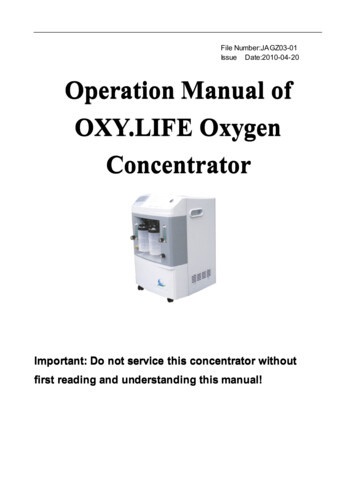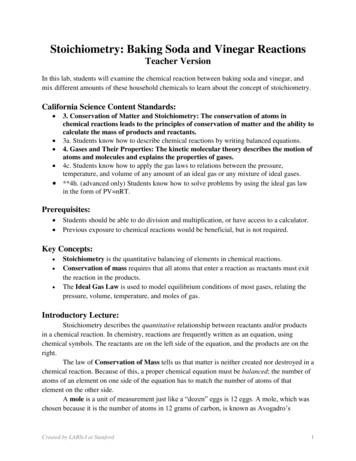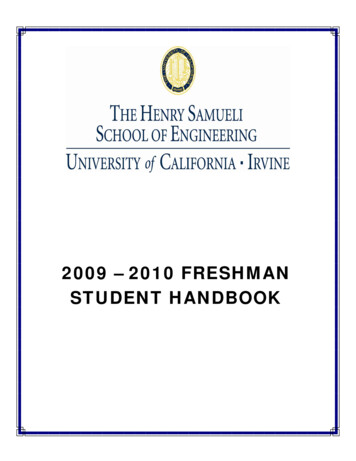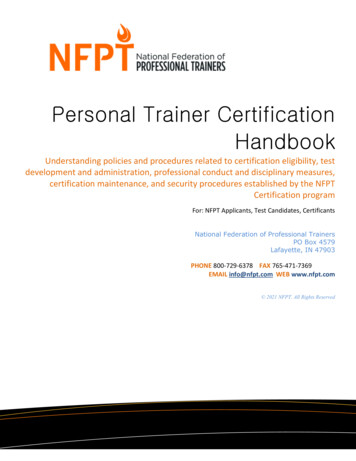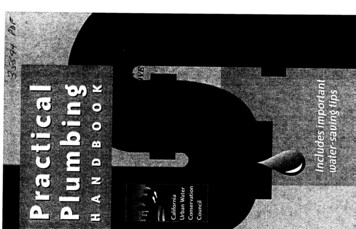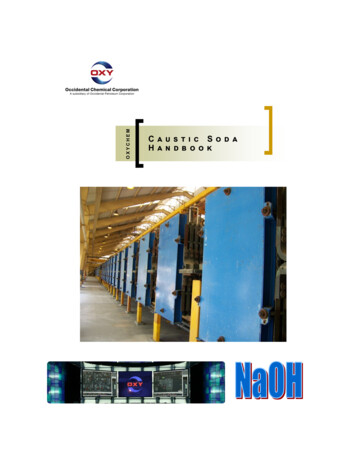
Transcription
OXYCHEMCaustic SodaHandbook
Occidental Chemical Corporation (OxyChem) is a leading North American manufacturer of polyvinylchloride (PVC) resins, chlorine and caustic soda — key building blocks for a variety of indispensableproducts such as plastics, pharmaceuticals and water treatment chemicals. Other OxyChem productsinclude caustic potash, chlorinated organics, sodium silicates, chlorinated isocyanurates and calciumchloride. OxyChem’s market position is among the top three producers in the United States for theprincipal products it manufactures and markets. Based in Dallas, Texas, the company hasmanufacturing facilities in the U.S., Canada and Latin America.OxyChem has been an active participant in the American Chemistry Council's Responsible Care initiative since its inception in 1988. Demonstrating their commitment to attaining the highest levels ofsafety and environmental achievement, Responsible Care companies implement world-classmanagement systems, measure performance based on industry-wide metrics, and are subject toreview by independent auditors.ForewordThis handbook outlines recommended methods for handling, storing, preparing and using caustic soda.It also includes information on the manufacture, physical properties, safety considerations andanalytical methods for testing caustic soda. Additional information and contacts can be found on theinternet at www.oxychem.comImportant: The information presented herein, while not guaranteed, was prepared by technicalpersonnel and is true and accurate to the best of our knowledge. NO WARRANTY OFMERCHANTABILITY OR OF FITNESS FOR A PARTICULAR PURPOSE, OR WARRANTY ORGUARANTY OF ANY OTHER KIND, EXPRESS OR IMPLIED, IS MADE REGARDING PURITY,PERFORMANCE, SAFETY, SUITABILITY, STABILITY OR OTHERWISE. This information is notintended to be all-inclusive as to the manner and conditions of use, handling, storage, disposal andother factors that may involve other or additional legal, environmental, safety or performanceconsiderations, and Occidental Chemical Corporation assumes no liability whatsoever for the use of orreliance upon this information. While our technical personnel will be happy to respond to questions,safe handling and use of the product remains the responsibility of the customer. No suggestions foruse are intended as, and nothing herein shall be construed as, a recommendation to infringe anyexisting patents or to violate any Federal, State, local or foreign laws.2
TABLE OF CONTENTSIntroduction4Principal Uses5Manufacturing6Methods of Shipping10Safe Handling11UnloadingUnloading railcarsHeating a railcarBottom unloading using gravityBottom unloading using pressureTop unloadingUnloading tank trucks14141619202022Equipment for Handling24Technical DataTable 1 Density and NaOH content of membrane grade caustic soda solutions at 60 FTable 2 Density and NaOH content of diaphragm grade caustic soda solutions at 60 FTable 3 Specific heats of caustic soda in Btu/lb· FGraph 1 Boiling and solidifying temperature of aqueous caustic soda solutionsGraph 2 Specific gravity of aqueous caustic soda solutionsGraph 3 Viscosity of aqueous caustic soda solutionsGraph 4 Vapor pressure of aqueous caustic soda solutionsGraph 5 Approximate resultant temperature when diluting caustic sodaGraph 6 Relative enthalpy of aqueous caustic soda solutionsGraph 7 Solubility of sodium chloride in aqueous caustic soda solutionsGraph 8 Thermal conductivity of aqueous caustic soda solutionsGraph 9 Specific conductance of aqueous caustic soda solutions28282930313233343536373839Dilution Calculations40Methods of AnalysisDetermination of the total alkalinity of caustic sodaDetermination of sodium hydroxide in caustic sodaDetermination of sodium carbonate in caustic sodaDetermination of sodium chloride in caustic sodaDetermination of iron in caustic sodaDetermination of other elements in caustic soda43434649535862Billing for liquid caustic soda63Bibliography64
INTRODUCTIONCaustic soda (sodium hydroxide or NaOH) is most commonly manufactured by the electrolysis of asodium chloride (NaCl) solution. OxyChem manufactures caustic soda using either membrane ordiaphragm electrolytic cells. OxyChem does not use mercury based electrolytic cells to produce causticsoda. The co-products formed from the electrolytic production of caustic soda are chlorine and hydrogen.Liquid caustic soda is available as a 50% solution in two main grades. The names of these main gradescorrespond to the electrolytic cells used to produce the caustic soda; membrane grade and diaphragm grade.OxyChem can also provide dilutions of various concentrations.The major difference in the two main grades is the amount of starting material (sodium chloride) remainingin the final product. Membrane grade caustic soda will have less than 100 ppm of the sodium chlorideremaining in the product. Diaphragm grade material will have less than 1.2% sodium chloride. Severalother differences can be seen in the products when the specification sheets are compared. Specificationsheets for each grade can be found on our website at www.oxychem.com.All OxyChem’s caustic soda meets the test requirements specified in the Food Chemicals Codex(FCC). Not all OxyChem’s caustic soda is produced following all cGMP (current Good ManufacturingPractices) requirements as defined by the FDA (Food and Drug Administration). OxyChem doesproduce a food grade caustic soda, which is produced following cGMP requirements as defined by theFDA. OxyChem does not represent or warrant general compliance of this product for food use. Eachprospective use of a product in a food or food related application must be carefully assessed againstappropriate regulations by the user and it cannot be assumed that products meeting FCC testrequirements are satisfactory for all uses without such assessment.OxyChem has played a leading role in providing caustic soda to meet the increasing demands of industry.OxyChem plants are strategically located to conveniently and economically serve industry.Caustic soda is shipped via pipelines, tank trucks, railcars, barges and ships. Terminals are used to maintainstocks of our caustic soda in many principal cities. Distributor stocks are also available in these andmany other cities and form a network of supply for the end user’s convenience.The largest users of caustic sodaare the pulp and paper, detergentand chemical industries. Causticsoda is also used in the alumina, oiland gas and textile industries,mostly for its alkalinity value. MembraneDiaphragm 4
PRINCIPAL USES AND CONSUMPTION OF CAUSTIC SODACaustic soda is one of the very few chemicals utilized in a very broad range of applications. Some principalproducts or processes in which caustic soda is used are:Acid NeutralizationChemical Manufacture of:Agricultural ChemicalsAmmoniaAluminumAmyl AminesBattery RecyclingCresolBleachEthylene AminesBoiler CompoundsFormic AcidCellulose FilmGlycerineDetergentsMaleic AnhydrideDrain CleanersPentaerythritolDrilling MudsPhenolDyestuffsPropylene OxideFood ProcessingPolycarbonatesFruit & Vegetable PeelingSalicylic AcidGlass-Batch WettingSodium AluminateIon-Exchange Resin RegenerationSodium HydrosulfideOre Floatation and ProcessingSodium HypochloritePaint RemoversSodium PhosphatesPetroleum RefiningStyrenepH AdjustmentVinyl Chloride MonomerPharmaceuticalsPigmentsPulp & PaperRayonSoapSurfactantsTextile BleachingVegetable Oil ProcessingWater Treatment
MANUFACTURING PROCESSCaustic soda is produced by OxyChem by an electrolytic process as shown in the following diagrams. Brine,prepared from sodium chloride (NaCl), is electrolyzed in either a membrane cell or a diaphragm cell. Theproduction of caustic soda (NaOH) also results in the co-products of chlorine and hydrogen.In the membrane process, a solution of approximately 33% in strength is formed. The solution is thensent to evaporators, which concentrate it to a strength of 50% by removing the appropriate amount ofwater.MEMBRANE CELL FLOW DIAGRAMSalt (NaCl)Brine TreatmentTreated BrineChlorinegasSulfiteDechlorinationDepleted BrineRiver WaterWater TreatmentDeionized WaterHydrogengasElectrolysis(Membrane Cell)33% Cell LiquorEvaporationCoolingCondensateCarbon DioxideCarbonate LiquorProductionCarbonate Liquor650%MembraneCausticSoda
MANUFACTURING PROCESSMEMBRANE CELL
MANUFACTURING PROCESSThe diaphragm process is similar to the membrane process except that a solution of only 12% is formedin the cell. Again, additional evaporation is required to reach the saleable concentration of 50%.DIAPHRAGM CELL FLOW DIAGRAMRiver WaterWater TreatmentClarified WaterChlorinegasSalt (NaCl)Brine TreatmentTreated BrineHydrogengasElectrolysis(Diaphragm Cell)12% Cell ltrationSaltCondensateCarbon DioxideCarbonate LiquorProductionCarbonate Liquor8
MANUFACTURING PROCESSDIAPHRAGM CELL
SHIPPING METHODSLiquid caustic soda is available from OxyChem’s many plants and terminals in tank truck, rail tankcar, barge and ship quantities. Each form of transportation has its own advantages. The type ofservice selected will depend upon such factors as size and location of storage, rate of consumption,plant location, freight rates, etc.Liquid caustic soda is regulated by the U.S. Department of Transportation (DOT) and isclassified as a corrosive material. The DOT identification number is UN I824 for liquid causticsoda.10
SAFE HANDLING CAUSTIC SODACaustic soda in any concentration must be respected by everyone who handles and uses it.Before starting to work with it, the user should be aware of its properties, know what safetyprecautions to follow, and know how to react in case of contact. Accidental exposure to causticsoda may occur under several conditions. Potentially hazardous situations include handlingand packaging operations, equipment cleaning and repair, decontamination following spills andequipment failures. Employees who may be subject to such exposure must be provided withproper personal protective equipment and trained in its use. Some general guidelines follow:1. Read and understand the latest Safety Data Sheet.2. Provide eyewash fountains and safety showers in all areas where caustic soda is used orhandled. Any caustic soda burn may be serious. DO NOT use any kind of neutralizingsolution, particularly in the eyes, without direction by a physician.3. Move the patient to a hospital emergency room immediately after first aid measures areapplied.FIRST AID MEASURESINHALATION: If inhalation of mists, vapors, or spray occurs and adverse effects result, removeto uncontaminated area. Evaluate ABC's (is Airway constricted, is Breathing occurring, and is bloodCirculating) and treat symptomatically. GET MEDICAL ATTENTION IMMEDIATELY.SKIN CONTACT: Immediately flush contaminated areas with water. Remove contaminatedclothing, jewelry and shoes. Wash contaminated areas with large amounts of water. GET MEDICALATTENTION IMMEDIATELY. Thoroughly clean and dry contaminated clothing before reuse. Discardcontaminated leather goods.EYE CONTACT: Immediately flush contaminated eyes with a directed stream of water for as longas possible. Remove contact lenses, if present, then continue rinsing. GET MEDICAL ATTENTIONIMMEDIATELY.INGESTION: If swallowed, do not induce vomiting. For definite or probable ingestion, do notadminister oral fluids. If vomiting occurs spontaneously, keep airway clear. Monitor airway. Volumeresuscitation (IV fluids) and circulatory support (CPR) may be required. Never give anything by mouth toan unconscious or convulsive person. GET MEDICAL ATTENTION IMMEDIATELY.
SAFE HANDLING CAUSTIC SODAPROTECTIVE EQUIPMENTOSHA requires employers to supply suitable protective equipment for employees. When handlingcaustic soda, the following protective equipment is recommended:Wear suitable chemical splash goggles for eye protection during the handling of caustic soda in anyconcentration. The goggles should be close fitting and provide adequate ventilation to prevent fogging,without allowing entry of liquids. The use of a face shield may be appropriate when splashing canoccur, including loading and unloading operations.Wear rubber gloves or gloves coated with rubber, synthetic elastomers, PVC, or other plastics to protectthe hands while handling caustic soda. Gloves should be long enough to come well above the wrist.Sleeves should be positioned over the glove.Caustic soda causes leather to disintegrate quite rapidly. For this reason, wear rubber boots. Wear thebottoms of trouser legs outside the boots. DO NOT tuck trouser legs into boots.Wear chemical resistant clothing for protection of the body. Impregnated vinyl or rubber suits arerecommended.Wear hard hats for some protection of the head, face and neck.If exposures are expected to exceed accepted regulatory limits or if respiratory discomfort isexperienced use a NIOSH approved air purifying respirator with high efficiency dust and mist filters.PROTECTIVE PRACTICESKeep equipment clean by immediately washing off any spill or accumulation of caustic soda.Weld pipelines where practical. Use flanged joints with gaskets made of caustic soda resistant materialsuch as rubber, PTFE, or EPDM rubber. If a screwed fitting is used, apply Teflon tape to the threads.When disconnecting equipment for repairs, first verify that there is no internal pressure on the equipmentand the equipment has been drained and washed.Provide storage tanks with suitable overflow pipes. Overflow pipes should be directed to a protectedoverflow area away from operations.Shield the seal area of pumps to prevent spraying of caustic solutions in the event of a leak.When releasing air pressure from a pressurized system, take every precaution to avoid spurts orsprays of caustic solution.In case of a spill or leak, stop the leak as soon as possible. After containment, collect the spilledmaterial and transfer to a chemical waste area. Remove large liquid spills by vacuum truck. Neutralizeresidue
Graph 3 Viscosity of aqueous caustic soda solutions 33 Graph 4 Vapor pressure of aqueous caustic soda solutions 34 Graph 5 Approximate resultant temperature when diluting caustic soda 35 Graph 6 Relative enthalpy of aqueous caustic soda solutions 36 Graph 7 Solubility of sodium chloride in aqueous caustic soda solutions 37 Graph 8 Thermal conductivity of aqueous caustic soda solutions
